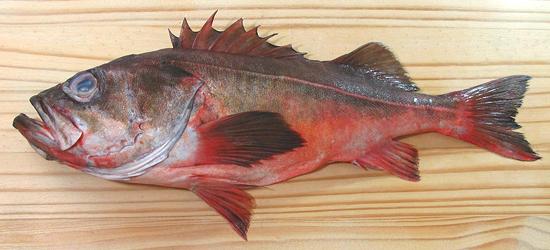 [Sebastes macdonaldi]
[Sebastes macdonaldi]
This rockfish is found from Santa Barbara, California, down to the tip of Baja California, Mexico, and in the Gulf of Mexico. It can grow to 26 inches and 6 pounds, but the photo specimen was 17 inches and 1 pound 14-3/4 ounces. This excellent eating fish and popular game fish is IUCN Red listed NE (Not Evaluated) and not considered endangered.
More on Rockfish.
Mexican Rockfish flesh is tender, off white and has light but interesting flavor. There is a thin layer of darker flesh right under the skin, but it is not noticeably stronger in taste than the lighter flesh.
The flesh holds together well for most types of cooking. It holds together well enough for poaching, and flakes apart well on the plate. For soup it should be put in near that last few minutes or it will start to break up into flakes. It is excellent poached or lightly powdered with rice flour and pan fried. This fish is not suitable for "whole fish" recipes because of its large head and skin shrink.
Buying: Mexican Rockfish occasionally appears in the Philippine fish markets here in Los Angeles, but is probably not common far from the coast, as the rockfish fishery along the Pacific coast is tightly controlled. The photo specimen was bought from a large Philippine market in Los Angeles (Eagle Rock), sold as Empire Snapper, which it most certainly isn't. Cost was 2016 US $2.99 per pound.
Scales: This fish is covered with very small scales that scrape off fairly easily and do not fly about much.
Cleaning: There's nothing unusual in cleaning this fish (see Method), but the esophagus is large and quite strong, so cut it off with kitchen shears. The gills are large and fairly firmly attached, but need not be pulled as the head is of no use.
Fillet: Mexican Rockfish is fairly easy to fillet, with an easy to follow fin ray and bone structure, and the flesh holds together well. First cut off the head, turning the knife steeply under the gill covers to get the maximum amount of flesh. Outline the fillet by cutting through the skin along the top, across the tail and especially along the bottom - cut a little deep and you can just pull the anal fin out. Cut from the top down following the bones to the backbone. Hop over the backbone at the tail and work forward. When you get to the ribcage just cut the ribs loose from the backbone with kitchen shears and pull them from the fillet with long nose pliers. Hold the flesh with your fingers on each side of the rib so it doesn't tear the flesh. There are some very substantial centerline pinbones for the length of the body cavity but they are easy to locate. Pull them straight forward, again holding the flesh in place. Method.
Skin: Skin shrink is severe, and it doesn't release from the flesh even when when cooked into jelly. The skin is thin but quite strong, and it's adhesion is poor. You can almost peel it off, so it's very easy to remove by the standard long knife and cutting board Method. Almost no flesh should be lost. I recommend simply cutting off the thin part of the skirt before skinning, as it will not contribute much flesh, and the unremovable membrane on the inside will cause it to curl strongly.
Yield: Yield is not high, because so much of this fish is head. A 1 pound 14-3/4 ounce fish yielded 11-1/4 ounces of skin on fillets (37%), but they usually need to be skinned, which would be 9-1/8 ounces (30%), presuming the thin part of the skirt is cut off.
Stock: The head, fins and bones, simmered slowly for 40 minutes, produced a murky stock with a strong smell and taste. I recommend you don't bother.
sf_rfmexiz 160517 - www.clovegarden.com